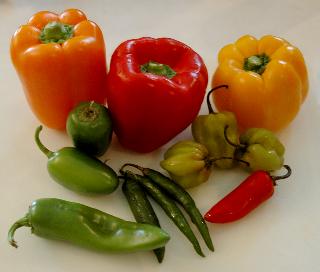
Cooking with
Hot Chilli Peppers
The use of hot or chili peppers such as, Habanero, Jalapeño, Serrano and Tabasco is an art.
Their "heat" can vary 1,000 to one.
There are literally hundreds of types (if not thousands) of hot peppers.
To the left are red, orange and yellow bell or "sweet" peppers with no heat and various common hot peppers including the
habanero (small round wrinkly peppers on the right).
Identifying hot peppers can be difficult as they all have most of the same features and can vary in size.
Many are used when ripe and green and others when red.
Those that turn red are sometimes used in the green, yellow and red stages. . . It can all be very confusing.
We purchased what was labeled a Serrano pepper at our local grocery.
But when I tried to identify it along with other peppers it was too large.
After much research I found that there is a Lago (large) Serrano that is twice as large as the common ones.
Some hints for using hot peppers.
- It is recommended to wear surgical gloves when handling hot peppers and to be careful not to get juice on you face or in your eyes.
Safety glasses may be warranted (just like cutting onions).
- Most hot peppers should have their seeds removed and the ribs scraped.
- Many recipes call for chopping the chili peppers into fine pieces.
We find that this can result in hot spots, especially in things that are not cooked like salsa.
It helps equalize the taste to put the chopped pepper into a blender with another item such as a tomato and blend them together.
- Some recipes call for roasting the peppers.
This is sometimes done on a hot griddle, sometimes on a charcoal grill and sometimes with an open flame such as from a propane torch.
- While we like some "hot" flavor in dishes such as salsa and a little zing to our beans we found many recipes used suicidal amounts of hot peppers.
In our salsa we used less than 1/2 of a Lago Serrano pepper in a large batch that made about 3 quarts.
Adjust the amount carefully and remember that as the dish steeps overnight the flavor may become more pronounced.
You can always add more, but it is difficult to take away without doubling or tripling a recipe.
- If you want to see nice big pieces of pepper in your food use sweet peppers such as Bell (sweet no heat) peppers or Poblano (a mild) pepper.
Use other peppers as above to taste.
Cooking with
The use of hot or chili peppers such as, Habanero, Jalapeño, Serrano and Tabasco is an art. Their "heat" can vary 1,000 to one. There are literally hundreds of types (if not thousands) of hot peppers.Hot Chilli Peppers
To the left are red, orange and yellow bell or "sweet" peppers with no heat and various common hot peppers including the habanero (small round wrinkly peppers on the right).
Identifying hot peppers can be difficult as they all have most of the same features and can vary in size. Many are used when ripe and green and others when red. Those that turn red are sometimes used in the green, yellow and red stages. . . It can all be very confusing. We purchased what was labeled a Serrano pepper at our local grocery. But when I tried to identify it along with other peppers it was too large. After much research I found that there is a Lago (large) Serrano that is twice as large as the common ones.
Some hints for using hot peppers.